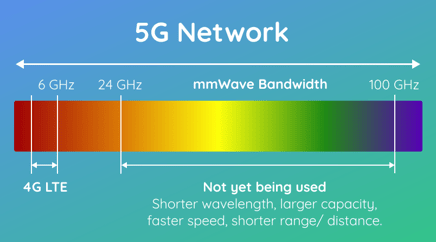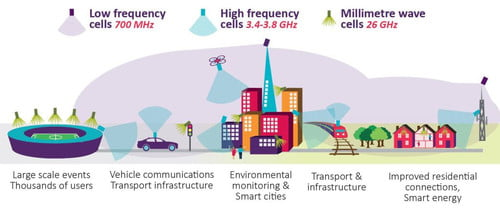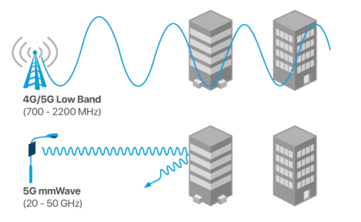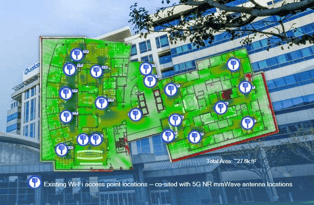The pros and cons of 5G for indoor positioning
Eva Cheng
Last updated: 28/04/2025
As 5G devices and networks continue to roll out, we're continuing to hear a great deal about the potential of 5G technology for exciting new applications. 5G networks have enormous implications for autonomous vehicles, emergency services, and industrial IoT use cases, where localization accuracy and reliability are critical.
Does 5G live up to its hype for indoor location? Is it ready to deploy in factories, retail stores, hospitals, workplaces, and other industries? In this article, we provide an overview of the current state of 5G localization. We compare 5G positioning to other indoor location technologies available today, such as Ultra-Wideband, Bluetooth, and WiFi, to help organizations choose the best technology to deploy location services.
How does 5G positioning work?
5G is the fifth generation of mobile connectivity. It is a new global wireless standard after 4G networks. It is advertised as superior to 4G in many ways. 5G operates through MIMO (Multi-user Multiple Input Multiple Output) antennas, which provide a precise orientation of the signal in one specific direction instead of a multidirectional broadcast. Before it can reach the level of ubiquity that means you and I can use it, wireless companies have to upgrade their radio antennas to work with the new network, and phone makers have to upgrade chips in their phones. It will take several years before 5G reaches parity with and then overtakes 4G.
|
4G Antennas (Multidirectional broadcast)
|
5G Antennas (MIMO and Angle-of-Arrival technology provides precise signal orientation and reduce unnecessary waves around the users) |
Fig. 1.: Unlike 4G, 5G does operate through MIMO (Multi-user Multiple Input Multiple Output) antennas, which act as directional headlights, for precise orientation of the signal in one specific direction, instead of a multidirectional broadcast. Source: Ela innovation
What frequency is 5G? As 5G can utilize a wide range of bands from lower bands like 3G and 4G up to very high-frequency bands, that’s a tricky question. The 5G network that is rolled out nationwide by major carriers today lives in the low-frequency bands, also referred to as Sub-6GHz bands. While Sub-6GHz 5G networks can handle more users than 4G networks, they don’t show substantial speed improvements compared to 4G.
So what is the “super-fast” 5G that is advertised as revolutionary? That would be high-band 5G, which lives between 24GHz and 100GHz (see Fig.2). This type of 5G can handle a large chunk of data allowing speeds to go over 1 Gbit/s. It is referred to as mmWave by Qualcomm and AT&T.

Fig. 2.: 5G network explained: MmWave refers to the radio frequency spectrum between 24GHz and 100GHz that is not yet being used in nowadays 5G technology. Source: Android Authority.
How accurate is 5G positioning?
mmWave vs. Sub-6GHz vs. 4G
|
Technology |
5G - mmWave |
5G - Sub-6GHz |
4G LTE |
|
Speed |
★★★
1.8 Gbit/s |
★★
50 - 400Mb/s |
★
35 - 53Mb/s |
|
Range |
★ |
★★ |
★★★ |
|
Environment |
Dense, urban areas, or specific targeted spots |
Suburban and rural areas |
Widely applied globally |
|
Scale |
★
Not enough base stations to support mmWave yet |
★★
Supported by limited devices |
★★★
Supported by most mobile devices |
|
Positioning Accuracy |
Less than 1 meter |
20 meters |
50 meters |
Table.1: Comparison between 5G networks and 4G LTE
Why are major carriers slow to roll out mmWave, if it allows for high accuracy localization? That’s because it is expensive to deploy. It takes a long time and a lot of money to build a 5G cell tower. Sub-6GHz 5G can do more with fewer cell sites and make use of existing towers. This means that operators can improve the speed and consistency of mobile broadband more quickly with Sub-6GHz 5G than it is possible with a mmWave deployment.
As a result, though mmWave 5G could bring the next generation of localization technology, it is expensive to deploy and operators don’t see the economic value of rolling it out nationwide. For most people, the speeds available on 4G and Sub-6 5G are adequate enough. If you’re streaming a 4K video stream on Netflix for example, you only need 25Mbp/s. At the moment, the economic reality means that for most use cases, Sub-6 5G is adequate.
5G for indoor positioning - the advantages
The core advantages of a theoretical 5G indoor positioning and navigation system are twofold:
-
5G is increasingly prevalent in consumer smartphones, meaning that in the future, it's likely that commercial-facing 5G systems would be able to work without needing to give end users specialized devices (as happens today with BLE-based systems, and which isn't possible with UWB and other more specialized technology)
- Under the right conditions, 5G is capable of delivering sub-1 meter accuracy, meaning it is more than adequate for all but the most involved indoor positioning use cases (most commercially-designed systems aim for sub-5 meter accuracy)
5G for indoor positioning - the disadvantages
Cost
The first crucial consideration for any business or venue considering a 5G-based system is one of cost.
As mentioned above in our advantages section, 5G functionality is becoming more common within smartphones, meaning that unlike certain technologies such as UWB, it is conceivable that at a point in the future, a customer-facing indoor positioning system (such as one installed in a retail store or airport) could leverage 5G without worrying about providing users with a specialized end device in order for them to access the system.
However, even in the future when 5G's ubiquity is such that end devices, the need to install costly hardware throughout a location is a much greater cost concern. For the next reason, it's unlikely this will ever be surmounted to the point where a system could rely on commercial 5G networks, meaning no choice but to install hardware.
mmWave has weak penetration and an ultra-short range
Another barrier to entry for mmWave is due to its technological limitations. mmWave 5G networks are ultra-fast, but they also have an ultra-short range and weak penetration. mmWave's performance can be affected significantly by doors, windows, walls, trees, vehicles and even humans. The density of base stations required to satisfy the quality of user experiences will be decided by the constraints of blockages and latency, rather than the requirements of coverage or capacity. Whereas 4G networks require 8-10 base stations per km², 5G networks would need as many as 40-50 base stations per km² (source: Newtec).
This diagram shows the difference of coverage between mmWave 5G base stations and lower-band base stations. The limitations of mmWave 5G make it best suited for dense, urban areas, or specific venues such as stadiums.

Fig.3: mmWave hardware provides very small coverage and will be focused on areas of high traffic demand, or to specific locations requiring services with very high capacity. (source: Ofcom)
With mmWave, indoor coverage is a challenge
As you may have already guessed, the issues with penetration and range faced by 5G in general present an enormous challenge when it comes to indoor positioning and indoor navigation. The same challenges faced by GPS (which you can read about in our post on GPS indoors) are also present for 5G. As mmWave don't penetrate through walls, even if carriers installed mmWave base stations at the top of each building, the 5G coverage wouldn’t propagate indoors.
mmWaves don’t penetrate inside buildings

Fig 4. (source: JMA wireless)
Instead, building operators would need to build their own private 5G network indoors in partnership with operators and purchase expensive 5G hardware to enable applications such as highly accurate indoor positioning. As mmWave technology does not penetrate walls, the hardware (“smart cells”) would need to be mounted in every room.
When trialing their 5G hardware in indoor environments, Qualcomm has found that for a 27,000 sqft office with just one floor, they would need to deploy 20 mmWave small cells, which would have to be connected to a base station, to achieve over 90% coverage. For multi-story buildings, you would need to install hardware on every floor. Due to the high density of expensive 5G hardware required, deploying private 5G networks indoors would only make sense for a convention center or a stadium, where there aren't many walls.
The density of 5G hardware required in a single floor office

Fig. 5 (source: Qualcomm)
In summary, 5G is a promising technology, but it currently cannot be used at scale for indoor positioning inside buildings due to technological limitations and high deployment costs.
Can 5G be used for indoor localization and tracking?
As indoor positioning technologies have improved, so have the requirements for businesses looking to use them. In the past, merely estimating where a user was to an accuracy of 10 meters was challenging enough. Now, with technologies such as Bluetooth and 5G steadily increasing what's possible in terms of localization accuracy, more businesses are asking whether use cases such as accurately tracking a device or user is possible.
In terms of whether 5G is suitable for indoor tracking, the basic answer is yes. 5G can, under suitable conditions, be an ideal technological base for an indoor tracking system, thanks in large part to the precise accuracy it's able to achieve of less than one meter. This is an improvement on many competing technologies in the indoor localization space.
However, the same drawbacks that apply to using 5G in more general indoor positioning ('blue dot') style systems also applies to a dedicated indoor tracking system. 5G's mmWaves struggle to pass through obstacles, and the technology (both transmitters and receivers) remains markedly more expensive and less widely adopted than technologies such as Bluetooth. This means that for an effective indoor tracking network based on 5G, the location in question would require a dense topography of beacons or transmitters, and the ability to have every user or item it wanted to track fitted with a 5G-enabled device (which cannot be said for all smartphones), both of which would increase costs significantly.
5G versus other indoor positioning technologies
In conclusion, we believe that 5G localization is a technology to watch for indoor positioning in the future. However, no one has implemented 5G localization yet, and people only talk about the possibilities of 5G for indoor location in theory. It is currently at a disadvantage of not being handled by most of today’s smartphones and mobile devices.
How can venue operators enable location services in their buildings today in a highly scalable, cost-efficient, and future-proof way? This overview compares the various indoor positioning technologies available today to help you make an informed choice.
|
Technology |
5G |
Deep Location® & Bluetooth |
WiFi |
UWB |
Geomagnetic |
|
|
Accuracy |
1 meter |
<3 meters |
5-15 meters |
Sub-meter |
10-20 meters |
|
|
Cost |
$$$$$ |
$$ |
$$$ |
$$$$ |
$ |
|
|
Scale |
+ |
+++ |
++ |
+ |
+ |
|
|
Privacy |
+ |
+++ |
- |
+++ |
- | |
|
Future proof? |
Supported by a limited range of mobile devices Not proven regarding IPS applications |
Officially supported by both Apple and Google Adopted by all major IoT technology players, including smart lighting and WiFi companies |
Not supported on iOS. |
Proprietary technology, not available for smartphones (today). There is no clear adoption path by Apple or Google.
|
Data privacy issues (not supported by Apple or Google) Especially challenging in venues with metal or water content. Doesn’t handle multi-floor very well either. |
Table.2: Comparison between 5G localization and other indoor location technologies that are available today.
5G and Deep Location®: the future of indoor location?
At Pointr, we invest heavily in R&D to ensure we stay well-positioned to bring our customers and partner the best indoor location technology. That’s why our R&D team is already testing 5G localization technology with our Deep Location® platform. Our Deep Location® algorithms are hardware and technology agnostic, and we will launch updated SDKs if and when we start seeing the adoption of 5G technology. We think that 5G localization will take some time to be affordable and widespread, but it has the potential to become the future of indoor positioning systems.
Pointr Deep Location® is a hardware-agnostic software platform resulting from years of R&D into high scale indoor location and mapping, protected by 18+ international patents. We partner with all major infrastructure providers, including Cisco, Honeywell, Panasonic, GE Current, and Extreme Networks, to provide the only complete and scalable location system.
If you would like to learn more about Pointr’s approach to R&D, please don’t hesitate to get in touch with our team.
Eva Cheng
Eva is Pointr's Product Marketing Manager, meaning she's uniquely positioned to discuss the complex technology that powers Pointr's market-leading products in a way that dispels many of the myths around indoor mapping and location. She's also an expert in the indoor location market at large, making her an authority on the benefits and drawbacks of different and sometimes competing approaches to solving the challenges of accurate indoor positioning.





